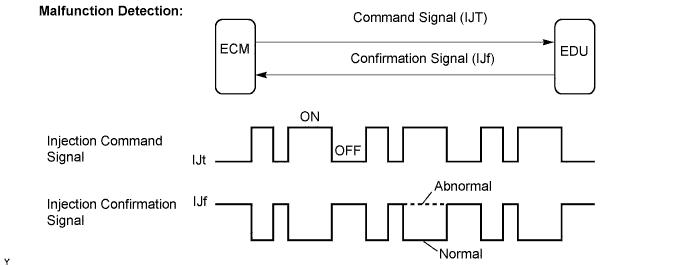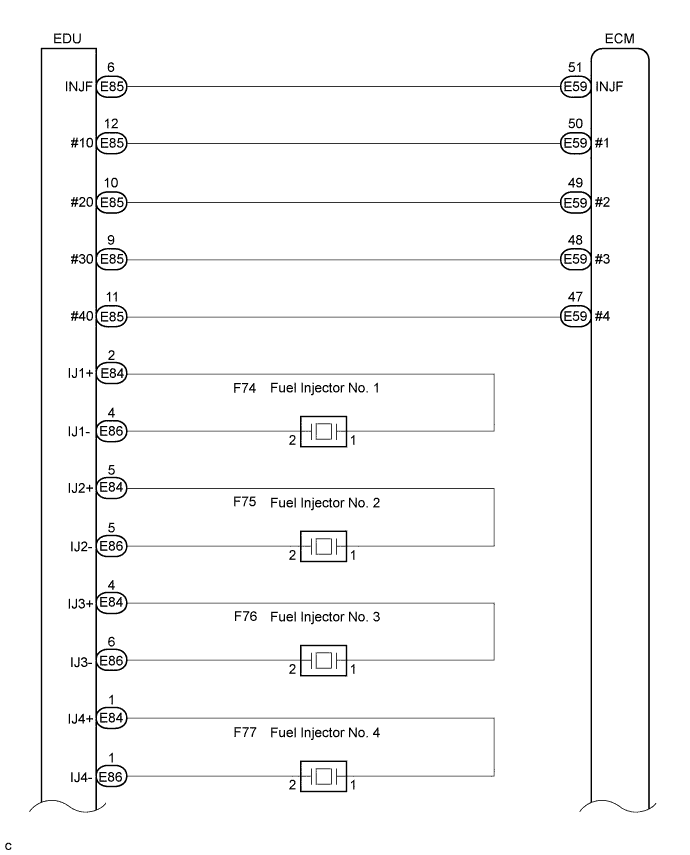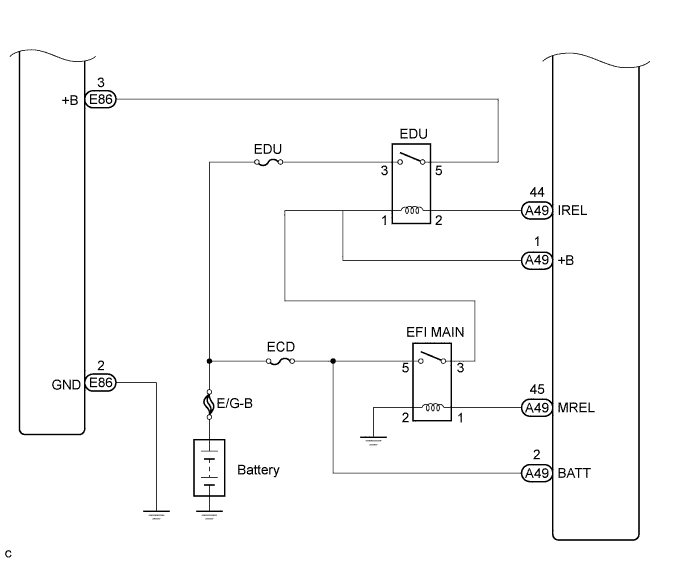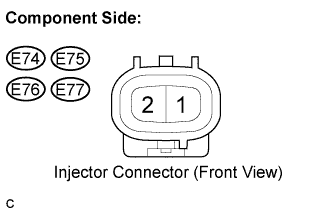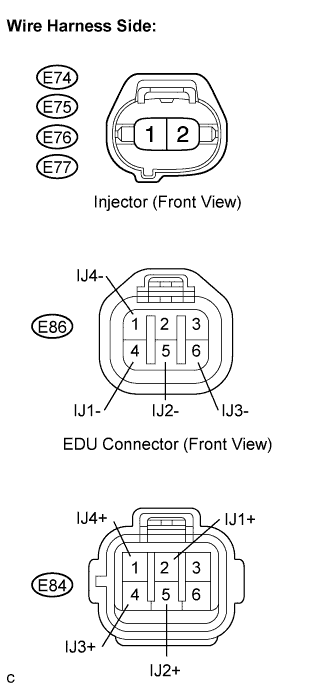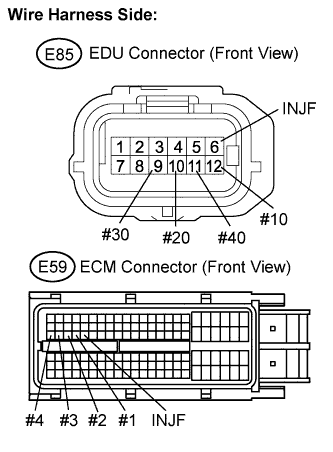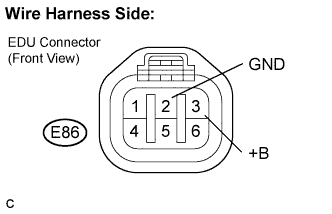Dtc P0200 Injector Circuit / Open
Engine. Lexus Is250, Is220D. Gse20 Ale20
DESCRIPTION
MONITOR DESCRIPTION
MONITOR STRATEGY
TYPICAL ENABLING CONDITIONS
TYPICAL MALFUNCTION THRESHOLDS
WIRING DIAGRAM
INSPECTION PROCEDURE
INSPECT INJECTOR ASSEMBLY
CHECK HARNESS AND CONNECTOR (INJECTOR - EDU)
CHECK HARNESS AND CONNECTOR (EDU - ECM)
CHECK EDU
REPLACE EDU
CHECK WHETHER DTC OUTPUT RECURS (THROTTLE POSITION SENSOR DTCS)
DTC P0200 Injector Circuit / Open |
DESCRIPTION
The EDU has been adopted to drive the injectors at high speeds. The EDU delivers high-speed drive signals under highly-pressurized fuel conditions using the DC/DC converter, which provides a high-voltage and quick-charging system.Soon after the EDU receives an injection command (IJt) signal from the ECM, the EDU responds to the command with an injector injection confirmation (IJf) signal when the current is applied to the injector.DTC No.
| DTC Detection Condition
| Trouble Area
|
P0200
| Open or short in EDU or injector circuit
After engine is started, there is no IJf signal from EDU to ECM, despite ECM sending IJt signals to EDU
(1 trip detection logic)
| - Open or short in EDU circuit
- Injector
- EDU
- ECM
|
- HINT:
- DTC P0200 is detected when starting the engine and letting it idle for 30 seconds.
MONITOR DESCRIPTION
- P0200 (Open or short in EDU or injector circuit):
The ECM continuously monitors both injection command (IJt) signals and injection confirmation (IJf) signals. This DTC will be set if the ECM determines that the number of IJt signals and IJf signals are inconsistent.
The injectors are grounded over a Field Effect Transistor (FET) and a serial resistor. This resistor creates a voltage drop, which is monitored by the EDU (injector drive circuit), in relation to the current drawn by the injector. When the injector current becomes too high, the voltage drop over the resistor exceeds a specified level and no IJf signal for that cylinder is sent to the ECM.
P0200 refers to a malfunction in the EDU or injector circuit.
If this DTC is set, the ECM enters fail-safe mode and limits engine power or stops the engine. The fail-safe mode continues until the engine switch is turned OFF.
MONITOR STRATEGY
Required sensors
| IJf signal from EDU
|
Frequency of operation
| Continuous
|
Duration
| 10 seconds
|
MIL operation
| 1 driving cycle
|
TYPICAL ENABLING CONDITIONS
Item
| Specification
| Specification
|
Minimum
| Maximum
|
Engine speed
| 500 rpm
| -
|
Battery voltage
| 11 V
| -
|
Engine switch
| ON (IG)
| ON (IG)
|
TYPICAL MALFUNCTION THRESHOLDS
Threshold
|
The injection missing counter* for all the cylinders, or for one individual cylinder, reaches a specified number (taking approximately 1 second after starting the engine)
*: Increments when no IJf signal is received from the EDU despite the ECM sending IJt signals
|
WIRING DIAGRAM
INSPECTION PROCEDURE
- NOTICE:
- After replacing the ECM, the new ECM needs registration (Click here) and initialization (Click here).
- After replacing an injector, the ECM needs registration (Click here).
| 1.INSPECT INJECTOR ASSEMBLY |
Disconnect the E74, E75, E76 and E77 injector connectors.
Measure the resistance of the injector.
- Standard resistance:
Tester Connection
| Condition
| Specified Condition
|
1 - 2
| 20°C (68°F)
| 0.9 to 1.1 MΩ
|
| | REPLACE INJECTOR ASSEMBLY |
|
|
| 2.CHECK HARNESS AND CONNECTOR (INJECTOR - EDU) |
Check the wire harness between the injector and EDU (INJ terminal).
Disconnect the E74, E75, E76 and E77 connectors.
Disconnect the E84 and E86 EDU connectors.
Measure the resistance of the wire harness side connectors.
- Standard resistance:
Tester Connection
| Specified Condition
|
E74-1 - IJ1+ (E84-2)
| Below 1 Ω
|
E75-1 - IJ2+ (E84-5)
| Below 1 Ω
|
E76-1 - IJ3+ (E84-4)
| Below 1 Ω
|
E77-1 - IJ4+ (E84-1)
| Below 1 Ω
|
E74-2 - IJ1- (E86-4)
| Below 1 Ω
|
E75-2 - IJ2- (E86-5)
| Below 1 Ω
|
E76-2 - IJ3- (E86-6)
| Below 1 Ω
|
E77-2 - IJ4- (E86-1)
| Below 1 Ω
|
E74-1 or IJ1+ (E84-2) - Body ground
| 10 kΩ or higher
|
E75-1 or IJ2+ (E84-5) - Body ground
| 10 kΩ or higher
|
E76-1 or IJ3+ (E84-4) - Body ground
| 10 kΩ or higher
|
E77-1 or IJ4+ (E84-1) - Body ground
| 10 kΩ or higher
|
E74-2 or IJ1- (E86-4) - Body ground
| 10 kΩ or higher
|
E75-2 or IJ2- (E86-5) - Body ground
| 10 kΩ or higher
|
E76-2 or IJ3- (E86-6) - Body ground
| 10 kΩ or higher
|
E77-2 or IJ4- (E86-1) - Body ground
| 10 kΩ or higher
|
| | REPAIR OR REPLACE HARNESS OR CONNECTOR |
|
|
| 3.CHECK HARNESS AND CONNECTOR (EDU - ECM) |
Disconnect the E85 EDU connector.
Disconnect the E59 ECM connector.
Measure the resistance of the wire harness side connectors.
- Standard resistance:
Tester Connection
| Specified Condition
|
#10 (E85-12) - #1 (E59-50)
| Below 1 Ω
|
#20 (E85-10) - #2 (E59-49)
| Below 1 Ω
|
#30 (E85-9) - #3 (E59-48)
| Below 1 Ω
|
#40 (E85-11) - #4 (E59-47)
| Below 1 Ω
|
INJF (E85-6) - INJF (E59-51)
| Below 1 Ω
|
#10 (E85-12) or #1 (E59-50) - Body ground
| 10 kΩ or higher
|
#20 (E85-10) or #2 (E59-49) - Body ground
| 10 kΩ or higher
|
#30 (E85-9) or #3 (E59-48) - Body ground
| 10 kΩ or higher
|
#40 (E85-11) or #4 (E59-47) - Body ground
| 10 kΩ or higher
|
INJF (E85-6) or INJF (E59-51) - Body ground
| 10 kΩ or higher
|
| | REPAIR OR REPLACE HARNESS OR CONNECTOR |
|
|
Disconnect the E86 EDU connector.
Turn the engine switch ON (IG).
Measure the voltage of the wire harness side connector.
- Standard voltage:
Tester Connection
| Specified Condition
|
+B (E86-3) - GND (E86-2)
| 9 to 14 V
|
| | CHECK EDU POWER SOURCE CIRCUIT |
|
|
| 6.CHECK WHETHER DTC OUTPUT RECURS (THROTTLE POSITION SENSOR DTCS) |
Connect an intelligent tester to the DLC3.
Turn the engine switch ON (IG) and turn the tester on.
Clear DTCs (Click here).
Start the engine.
Allow the engine to idle for 15 seconds or more.
Select the following menu items: Powertrain / Engine and ECT / DTC.
Read DTCs.
- Result:
Display (DTC Output)
| Proceed to
|
P0200
| A
|
No output
| B
|

